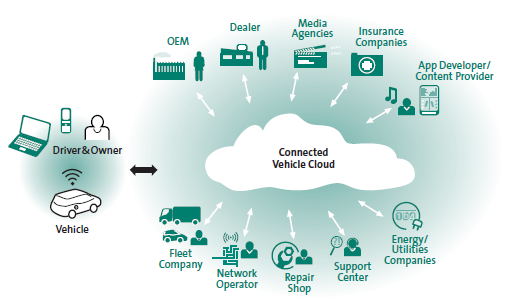The Internet of Everything (IoE) is becoming a major disrupting force that is driving new opportunities and business models across many industries. Businesses now have access to new customers and enterprise data that were not previously available. This new data enables organizations to understand customer behavior and preferences in a more customized and granular manner, develop innovative products and services, re-engineer processes and operations in a more efficient and scalable way. They are driving the evolution of new business and operating models that scale beyond seemingly unrelated organizations and industries.
Introducing the IoE and Its Benefits
The Internet of Things (IoT) describes the rapidly expanding array of computing devices, including wearables, smartphones and tablets, which use network technologies to exchange and process data collected from “things” – physical objects and places equipped with electronic tags, sensors, cameras and actuators. The Internet of Everything (IoE) ([Hoss14]) takes the IoT to the next level, adding the ability of the network to take autonomous action, execute business processes in real time and with little human intervention, and support decision-making through improved data models.
Analysts forecast that by 2020 the number of computing devices with unique IP-addresses connected to the Internet will reach 25 billion – from 4.9 billion in 2015 – while IoE’s potential value has been estimated to be $14.4 trillion in 2022 ([Brad13]).
So where does the new economic value come from? Most of the early adopters and applications come from industries such as manufacturing, utilities and transportation that have used proprietary technologies to automate business processes for many years. Now, the commoditization of high performance computing, enabling technologies and connecting networks is creating a host of new opportunities for organizations across all industries. They can increasingly afford to use tags, sensors, cameras, mobile gateways, and web services to connect the real and virtual worlds. The business case for IoE can be articulated in terms of four major drivers:
Increased cost efficiency
Many organizations reduce costs as they move from proprietary business process automation and management technologies to solutions based on commoditized technologies such as low-cost sensors, general purpose hardware, open-source software and cloud sourcing. The broad availability of these commoditized solutions and technologies allows a more accurate and real-time monitoring of demand, inventories and resources, on-the-fly optimizations, and more efficient elimination of waste.
For example, the defense and aerospace contractor Raytheon has installed a new manufacturing execution system that makes use of Big Data analytics and general-purpose technologies to deliver enterprise-wide manufacturing visibility, intelligence, and real-time optimization. The system is meant to analyze data collected on the factory floor from automatic torque controllers and screwdrivers, in order to catch production flaws as they occur and reduce the unnecessary costs that have been spent in the past on reworking, repairing and replacing parts that had not been installed properly or did not meet specifications ([Hage13]).
Enhanced productivity
Advanced automation is employed to diagnose problems, trigger replacement orders for components, schedule service calls, and conduct preventative maintenance, thereby reducing the number of expensive on-site trips by the service staff, and shortening the time required to diagnose and repair malfunctions. For example, Diebold, a company that manufactures and services self-service transaction systems, has deployed a new solution to remotely service its ATMs. This solution provides service more efficiently and cost-effectively while delivering higher uptime and productivity to customers. The new system allows the company to service the machines and respond to issues within minutes, as opposed to sending a technician to the location every time there is a problem. As a result of the new implementation, Diebold has reported a 17% increase in remote issue resolution, a 15% reduction in equipment downtime, and a reduction in average downtime response to below 30 minutes ([PTC]).
Improved service quality
Organizations across many industries are increasingly analyzing data collected automatically through the IoE in order to better understand and predict customer needs and behaviors, adjust inventories, and improve the quality of products and services. For example, online retailers routinely analyze Internet traffic volumes, clickstreams, ordering histories, and social networking posts to reduce out of stock occurrences, to target promotions, and to improve overall user experience.
Similarly, communities increasingly use a variety of IoE applications and enabling technologies through innovative models such as “the connected city” to better understand how their infrastructure and assets are utilized. In doing so they can provide better service to citizens. For example, the city of Amsterdam has deployed a self-regulating system to improve the traffic flow in a large area. The system combines information from various road managers based on data provided by 2400 vehicle-detector stations and about 60 number-plate recognition cameras. The first evaluation shows that, since the introduction of the new system, the percentage of vehicle-loss-hours in the Amsterdam region has decreased by as much as 10% ([Traf]).
Spur innovation and growth
An increasing number of equipment manufacturers and service providers view the IoE as a strategic platform that offers opportunities for innovation and growth beyond basic incremental productivity and quality improvements. For example, automotive companies partner with software suppliers and telecom providers to collect data from connected cars, identify usage patterns, tie those back to customer sentiment and perceptions, and then introduce value-added services to generate new revenue streams.
For example, in the case of connected cars, Volvo’s Sensus Connect service was the result of three companies — Volvo Cars, Ericsson and AT&T – collaborating around innovation. Ericsson provides its Connected Vehicle Cloud (CVC) solution as a managed service to its partners. CVC provides the technology platform including connectivity, service enablement, content management, charging, billing and customer care. The solution, which has the ability to cut across manufacturers’ organizational silos, supplier and distribution channels, is customized to meet Volvo’s needs. AT&T positions itself as a leading operator for connected car services as it leverages Ericsson’s solution and extends it to other services on the network, including enabling a Sensus Connect-equipped Volvo to serve as a Wi-Fi wireless hotspot ([Eric12]).
These organizations view the IoE as a collaborative platform that enables them to partner with insurance companies, governments, content providers, financial institutions and others to create new business models and deliver innovative offerings with new revenue streams (Figure 1).

Figure 1. An Automotive Ecosystem (source: Ericsson).
Expanding the IoE into a Broad Platform for Innovation and Growth
While a few organizations have already turned the IoE into a platform for collaboration, many more are experimenting with this new innovation and growth model across a broad spectrum of use cases including:
- Detecting and reacting to abnormalities in industrial facility operations. Site managers and security services providers capture and share data from meters, sensors, cameras and computers. Using advanced analytics, they are able to separate malfunctions from security threats in real-time, and take appropriate remedial actions that range from problem diagnosis and resolution to automated pattern analysis and event prediction for proactive facility management.
- Reducing operational overheads in buildings. Using analytics to harness the data collected from sensors, remote thermostats and lighting controls, building owners and property managers learn more about how to obtain demonstrable cost savings by more effective management of the heating, ventilation and air conditioning (HVAC) systems, lighting and security.
- Improving personal health quality and reducing insurance premiums with connected health. Consumers and employers collaborate with insurance companies, healthcare providers, telecom providers and regulators to improve the health of their employees. By deploying health and fitness wearables to employees and using incentive-based models, employers are promoting a healthier workforce and creating the potential for insurance-premium reductions.
A Few Challenges Keep Many IoE Initiatives at Bay
There is no doubt that the IoE is already having an impact across many industries, but while most executives acknowledge the intention to invest in IoE initiatives, many struggle to take the first step, unsure of how to get started and where to go. So what is restraining them?
We identified a few common challenges from our experience working with clients, including:
- Articulating the business case. IoE is still viewed as “bleeding-edge” technology with a lot of associated hype that organizations instinctively shy away from. Furthermore, many senior executives do not believe that their organizations are ready to test the waters. Some leaders also have trouble identifying clear use cases beyond the examples typically seen in the press. As a result they cannot articulate the business case or quantify the return on investment.
- Addressing security and privacy concerns. While the IoE offers many benefits, it can also result in serious harm to stakeholders, as in cases where hackers take control of equipment or data are leaked in undesired ways. As organizations invest in the IoE, they will need to also invest in scalable, faster and more resilient security and risk management architectures that are able to anticipate and effectively protect the network in the face of attacks and adverse conditions ([Fona15]).
- Defining the right architectures and tackling interoperability. With some of the IoE technologies and standards still under development, many organizations have difficulties establishing the right architectures, specifying products and interfaces, selecting vendors, and sequencing their deployment. Many executives also perceive that solving the technical challenges is easier than fixing process interoperability and communication issues among organizational silos, stakeholders from different sectors, and competitors. A change of mindset will be necessary to modify work processes, overcome skepticism among players, and free the flow of data across the IoE.
- Developing analytic expertise. Whereas fixing technical and process interoperability issues is an absolutely necessary condition of making the IoE work, the most crucial aspect is the ability to make use of the flow of data. This involves hiring and developing experts who have a unique skills set that combines a deep understanding of the business, advanced mathematics, IT and data analytics.
- Overcoming IT’s legacy operating model. Developing technology-enabled solutions in the age of digital disruption requires a completely different approach. The traditional plan-build-run operating model cannot deliver the speed, agility and flexibility the market demands. Many organizations still need to undergo the transition to a next-generation IT operating model that can rapidly iterate solutions and incrementally deliver capabilities. Key areas that require renewed focus include governance, portfolio and architecture management, business process management, service and vendor management, agile development, and operations ([Snyd15]).
Advanced Analytics and Information Management Are Business-Critical
We believe that, in the coming years, IoE will significantly impact the strategy and investments of every organization and leader, whether he or she is a CIO, CEO or other senior executive. Success and differentiation will begin and end with the organization’s ability to capture, store, secure and analyze the avalanche of data produced by IoE devices, and turn it into a sustainable source of competitive advantage. Building this capability requires not only investment in automation and analytics platforms but also an effective approach to information governance and management, including policies, resources and processes to ensure that the technology architecture and data processing are aligned with business priorities and strategies.
Business leaders must start any IoE related initiative by purposely building its information management (IM) foundation. We recommend three basic steps:
- Make the case for change. Because the potential applications for the IoE are truly vast, it is important to prioritize focus areas by created value and benefits delivered. Then revisit each area to determine which data are already available, how they are currently managed, and what kinds of new transactional data you will be able to access and analyze. Finally and most importantly, determine whether or not these enhanced capabilities can provide new and valuable information insights.
- Define the IM foundation for your business. The key thing to remember when performing this step is that IM must directly support your business strategy. As such, there are three basic questions you should be asking: First: To meet my business goals, what kind of data do I need? Then: What are the sources of the data I need? Finally: How do I get, consume and use these data? The answers to these questions create the foundation of your IM approach, which typically needs to cover three distinct areas: data acquisition and ingestion, data integration and mastery, and data distribution and consumption.
- Transform the operations around advanced data analytics. As you develop the IM foundation of your business, you will need to revisit your operating model and enhance it. In addition to investing in advanced analytics, in IM automation, and in enabling technologies such as sensors and actuators, you may need to review your HR priorities and focus on hiring and training data analysts who understand the business and can operate the new technologies. And it is critical to establish a data governance program that is cognizant of the specific risks associated with the IoE technologies and has the authority and responsibility to balance between the information needs of the business stakeholders, including business units, partners and individual users.
Conclusion
IoE is here today and, for organizations with an appetite for transformation and risk, there is a plethora of opportunities to develop innovative and highly differentiated products. To make it happen, organizations need a strategic, thoughtful approach to information management that leverages recent data analytics and connectivity advances. Organizations need to:
- start now by incrementally investing in IoE connectivity and analytics capabilities to discover/unleash their potential, make the business case, and develop a sustainable information strategy. Consider creating a cross-function R&D group.
- be a leader, not a follower. As more and more devices come online, early adopters will have first mover advantage and be in a position to influence standards.
- collaboratively deploy a holistic approach to IM, aligned with the organization’s business priorities, objectives and capabilities.
- think outside of the box. Which other adjacent industry partners could benefit from your data, and to what extent could you could benefit from theirs? This will drive opportunities to monetize your data while generating new business opportunities and value.
- navigate the related security and privacy challenges and adjust for the organization’s appetite for transformation and risk.
References
[Bell14] G. Bell, D. Rotman and M. Vandenberg, Navigating Big Data’s Privacy and Security Challenges, 2014, http://www.kpmg-institutes.com/content/dam/kpmg/advisory-institute/pdf/2014/big-data-privacy-security.pdf
[Brad13] J. Bradley, J. Barbier and D. Handler, Embracing the Internet of Everything To Capture Your Share of $14.4 Trillion, Cisco, 2013.
[Econ13] The Economist Intelligence Unit, The Internet of Things business index, http://www.arm.com/files/pdf/eiu_internet_business_index_web.pdf
[Eric12] Ericsson, Connected Vehicle Cloud, 2012, http://www.ericsson.com/industry-transformation/wp-content/uploads/sites/7/2014/09/Connected-Vehicle-Cloud-RevB2.pdf
[Fona15] P. Fonash and P. Schneck, Cybersecurity: From Months to Milliseconds, Computer 48 (1), 2015, http://ieeexplore.ieee.org/xpl/articleDetails.jsp?arnumber=7030229
[Hage13] J.R. Hagerty, How Many Turns in a Screw? Big Data Knows, The Wall Street Journal, May 15, 2013, http://www.wsj.com/articles/SB10001424127887324059704578472671425572966
[Hoss14] J.M. Hoss and B. Brunsman, The Internet of Everything is Now, KPMG, 2014, http://www.kpmg-institutes.com/institutes/advisory-institute/articles/2014/07/internet-of-everything.html
[KPMG14] KPMG, How to Realize the Promise of Disruptive Big Data Platforms, 2014, http://www.kpmg-institutes.com/institutes/advisory-institute/articles/2014/08/realize-big-data.html
[PTC] Smart Connected Products and Internet of Things Customer Case Studies, http://www.ptc.com/internet-of-things/smart-connected-products/customer-success
[Snyd15] M.E. Snyder, Next Generation IT Operating Models, KPMG, 2015, http://www.kpmg-institutes.com/content/dam/kpmg/advisory-institute/pdf/2015/next-generation-it-operating-models.pdf
[Traf] TrafficLink, Improvement of the (inter)regional traffic flow, http://amsterdamsmartcity.com/data/file/PDF%20Improvement%20regional%20traffic%20flow.pdf




